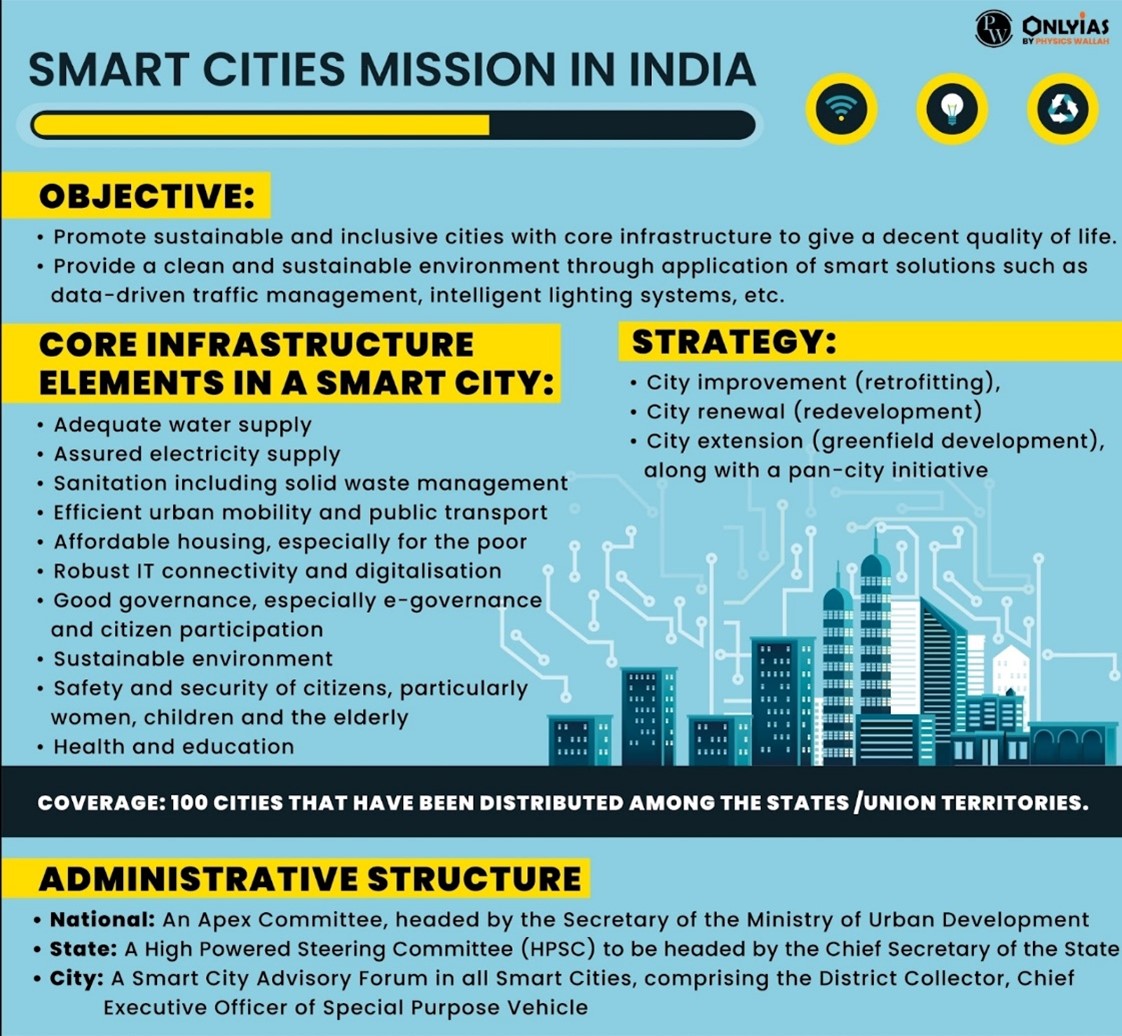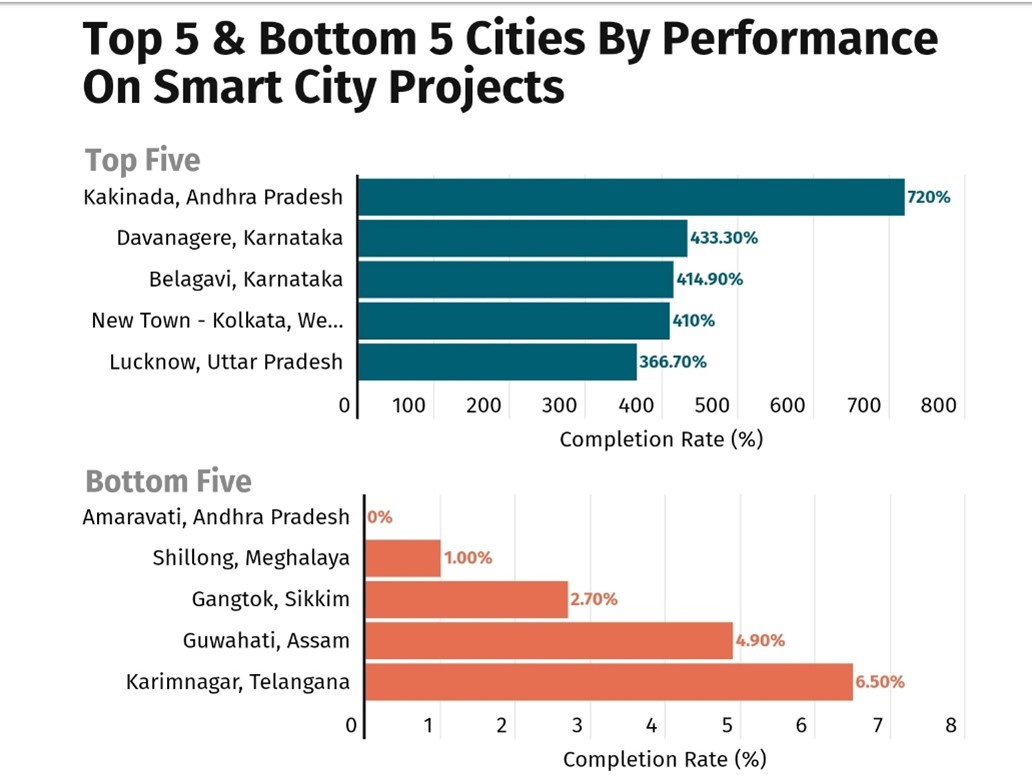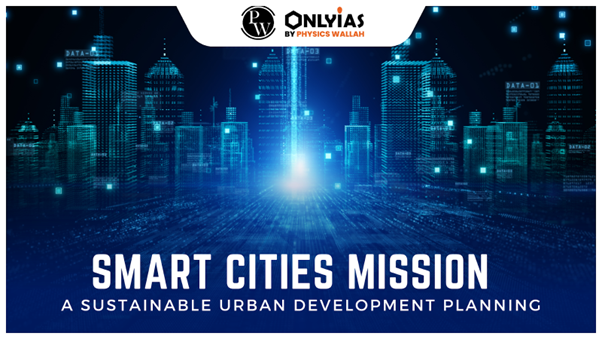Context:
| Relevancy for Prelims: Smart Cities Mission, Sustainable Development Goals, SDG 11, Project in Visakhapatnam, and Public-Private Partnership (PPP).
Relevancy for Mains: Sustainable Urban Development Planning, Need of Smart Cities Mission, Government programs for Sustainable Urban Development, and Challenges in Smart Cities development. |
Key Highlights of the report On Smart Cities Mission
- First comprehensive evaluation: It represents the first comprehensive attempt to evaluate the projects under the Smart Cities Mission(SCM).
- Alignment with SDGs: More than 70% of projects within the SCM align with the United Nations’ Sustainable Development Goals (SDGs) related to cities, clean water and sanitation, clean energy, and economic growth.
- The Smart Cities Mission (SCM) projects have played a significant role, to varying degrees, in advancing 15 out of the 17 SDGs.
Smart Cities Mission Success stories:
- Project in Ahmedabad: Sensor-based monitoring of the water network resulted in an additional supply of 50 million litres a day (MLD) by detecting leakages.
- Project in Indore: Gravity-based network was used to prevent 205 MLD of untreated sewage from entering the Kahn river, the Saraswati river and the network of 25 drains.
- Project in Visakhapatnam: Mudasarlova Reservoir Floating Solar Plant led to an annual electricity generation of 3,613 MWh and saved $0.28 million.The project prevented emission of over 3,000 tonnes of CO2.
Global technological solutions for urban problems:
- Barcelona: It embraced the Internet of Things (iOT) and is saving $ 58 million a year in water-efficient solutions and a further $ 37 million annually through lighting technologies, with the additional benefit of creating 47,000 jobs by engaging the local technology ecosystems.
|
-
- The SDGs consist of 17 targets, which are part of the 2030 Agenda for Sustainable Development. This agenda was adopted by all United Nations member states, including India, in 2015. SDG11: Nearly 44% were in line with the aim of SDG 11 — to make cities and human settlements inclusive, safe, resilient and sustainable.
- SDG6: 13.3% of Smart Cities Mission projects contribute to SDG 6 (Clean water and sanitation), 8.6% to SDG 7 (Affordable and clean energy), and 6.4% to SDG 8 (Decent work and economic growth).
Need of Smart Cities Mission:
- Increasing urbanization of India: Cities accommodate nearly 31% of India’s current population and contribute 63% of GDP (Census 2011).
- It is projected that by 2030, India will have around 60 cities with populations exceeding 1 million inhabitants, and 6 megacities with populations surpassing 10 million.
- Urban areas are expected to house 40% of India’s population and contribute 75% of India’s GDP by 2030.
- Unplanned urbanization: The Smart Cities Mission is a significant initiative, because most of Indian cities have grown in an unplanned manner and they are not fully equipped to deliver basic services like housing, water and sanitation to the growing number of residents.
-
- In 2019, New Delhi and Mumbai ranked 118th and 119th respectively, on the Economist Intelligence Unit’s Global Liveability Index 2019 that covered 140 cities.
- Strain on infrastructure and public services: Increased urbanization is exerting immense pressure on urban areas to provide essential resources.
- Megacities like Delhi and Mumbai face challenges due to heavy rainfall, resulting in issues like power outages and prolonged internet disruptions. .
- Technology-led solutions for urban problems: Today, urban services delivery is hindered by inadequate funding, traditional legacy systems, lack of data and restrictive policies and regulation.
- With constrained resources, rising inequity and climate change, technology-led innovation can be address in smart cities mission.
What are the challenges in Smart Cities Mission?

- Misleading Picture: As per the report of the Parliamentary Standing Committee on Housing and Urban Affairs 2023, 32 Smart Cities have completed more than the number of projects planned for implementation.
- On the other hand, the remaining 68 Smart Cities are yet to meet the project completion targets, wherein the performance of some cities is quite dismal. Ex–Meghalaya has not completed even a single project.

- Undermining financial autonomy of local bodies: The Special Purpose Vehicles (SPVs) are executing the smart cities mission through a Public-Private Partnership (PPP) model.
- These SPVs were intended to streamline the establishment of smart cities and minimize political complexities.
- In contrast, this has led to a significant disruption and undermining of the governance structure of Urban Local Bodies (ULBs).
- Lack of transparency: There is an absence of transparency when it comes to disclosing information and pertinent specifics related to proposals and projects.
- Beyond the impressive statistics used to highlight project achievements, there is a notable scarcity of detailed information available to the public.
- Conditional assistance: It has conditions and a “reform” agenda that incentivizes ULBs to prioritize competition.
- They are evaluated based on their performance in scheme implementation, which places local governments under pressure to secure additional resources.
- Consequently, ULBs find themselves compelled to invest in projects that rank lowest in priority for their cities and are not aligned with their specific needs.
- Functional autonomy of ULBs: After over 25 years, ULBs remain ill-equipped to govern in most urban areas.
- Most of the functions remain under the control of the state governments and at best, sanitation and basic service provisions are under local bodies’ control, Mumbai and some other cities being an exception.
- Absence of Master Plans: A recent report by NITI Ayog titled Reforms in Urban Planning Capability in India claims that master plans are absent in 65 percent of the 7,933 recognised urban entities.
- It is a tool for determining the proportions of land and infrastructure required for various urban uses.
- Exclusion of Census Towns: There are a large number of Census Towns (3894) which are not covered under Smart Cities Mission.
- Census Towns are mostly governed by Village Panchayats, which lack resources and institutional capacity but have the potential to act as a bridge between rural and urban areas.
- Incorporation of census towns in the fold of urban development strategy will unlock the possibilities of utilizing urbanization as a catalyst for rural development.
The Indian Census identifies two categories of ‘urban’ areas:
- Statutory towns: Those which have urban local bodies like municipal corporation, municipality or municipal committee.
- Census towns: All those places satisfying the following 3 criteria:
-
- Population of atleast 5000 persons
- Minimum population density of 400 persons per sq. km
- 75 per cent of the male workforce is employed in the non-agricultural activities
|
Other government programs for Sustainable Urban Development:
- National Mission for Sustainable Habitat (NMSH)
- Atal Mission for Rejuvenation and Urban Transformation (AMRUT)
- Swachh Bharat Mission-Urban (SBM-U)
- Deendayal Antyodaya Yojana-National Urban Livelihoods Mission
- Pradhan Mantri Awas Yojana-Urban
|
Also read: Housing for All
Way Forward
- Budgetary allocations: Policy frameworks/guidelines need to be included in the smart cities mission along with mechanisms to provide funding support to public space projects in cities.
- Financing cities for developing sustainable and climate-resilient infrastructure like developing non-motorized transport infrastructure, increased green cover, developing urban forests, etc.
- Emphasizing local economic development: Frameworks/guidelines need to be developed to facilitate the development of city economic development plans.
- State/ City Governments should be incentivized for developing and adopting such a framework.
- Enabling evidence-based planning – The cities under Smart Cities Mission India are implementing multiple digital solutions including Integrating Command Control Centers.
- These digital solutions are also collecting large volumes of data.
- Leveraging such data, States/Cities may be encouraged to formulate evidence-based policies/guidelines that will enable better urban development.
- Autonomy to ULBs: Principles of decentralization, and empowerment of urban local bodies through financial support and autonomy, coupled with the participation of its citizenry are necessary.
- Reliability of utility services: For any smart city in the world, the focus is on the reliability of utility services, whether it is electricity, water, telephone or broadband services.
- Smart cities should have universal access to electricity 24/7; this is not possible with the existing supply and distribution system.
- Cities need to shift towards renewable sources and focus on green buildings and green transport to reduce the need for electricity.
- Robust monitoring mechanism: Ground verification of projects by a team consisting of the Mission Director, State representative and local Member of Parliament and MLA.
Conclusion
Smart Cities Mission in India, as highlighted in the report, showcases a positive impact on sustainable urban development, aligning with global goals. However, challenges such as project disparities and governance issues need addressing. Focusing on local autonomy, transparency, and evidence-based planning can enhance the mission’s effectiveness for creating resilient and inclusive urban spaces.
| Attempt the Mains Question: What are ‘Smart Cities’? Examine their relevance for urban development in India. Will it increase rural-urban differences? Give arguments for ‘Smart Villages’ in the light of PURA and RURBAN Mission. (GS Paper 3: UPSC Mains 2016) |
![]() 28 Sep 2023
28 Sep 2023



